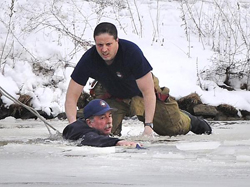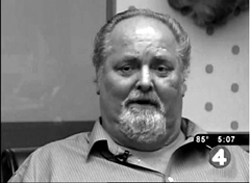Lewiston Road: Safe or Not?
By Darryl McPherson
 |
| Zona who lives near Lewiston Road is a fireman as well as a County legislator. He is pictured here during a rescue operation at Hyde park |
 |
| David Pfeiffer: Is his concern over radiaton legitimate? |
When anyone speaks of the delayed and over-budget Route 104 Lewiston Road construction project, there are two notable concerns. One concern is when will it get done, and the other - perhaps more crucial - is it safe?
Part of the dispute that has delayed the project (which now finds itself in court) deals with the amount of radioactive material discovered during the repaving process. It was originally estimated that there was only 550 yards of radioactive fill known as “slag.” Nw it is thought that it could exceed 7,000 yards.
The contractor, Man O’ Trees, found far more slag than what was presented in the bid specifications for the job. The City of Niagara Falls believes Man O’ Trees went searching for radioactive sites to remediate, and thus incurred unnecessary costs for work outside the scope of the project.
Man O’ Trees president and owner David Pfeiffer felt it was necessary to warn the public along Lewiston Road of its presence, and sought a plan from the city to remediate the danger.
"All I want is to let everyone know it's there," Pfeiffer told the Reporter. "It's there, and it's bad."
Pfeiffer’s opinion is not shared by everyone. The New York State Department of Environmental Conservation contends that there is “no immediate threat” to the residents along Lewiston Road. Yet, the Reporter obtained a secretly recorded conversation made by Pfeiffer with his safety consultant Evan Casey of Great Lakes Environmental.
Pfeiffer spoke frankly about the risk as he perceived it.
Pfeiffer: “Would you or would you not build a house there, with 25,000 clicks of a Geiger counter? Do you want to raise your family there?”
Casey: “No. I wouldn't.”
Pfeiffer: “You know a lot more than me and I wouldn’t. You wouldn’t. Why do [the residents] have to?”
Last week, the Reporter held a community meeting at the Maple Avenue Elementary School to give the residents a chance to air their concerns. While there were some people worried about the health risk, almost as many displayed a lack of concern.
They were more frustrated by the lack of progress on the project, and seemed satisfied with the results of previous studies and the assurances that the area was safe.
Niagara County Legislator Jason Zona (D – 5th District), who also attended the meeting, was not as easily convinced.
“We need to know what’s under there, what’s in the air, what’s in the ground as well. More so, what’s in the air because that thing’s been open for so long. I’ll be reaching out to Greg Young from the State Health Department to get some air samples and put out a public statement on this.”
Zona would like to see something released officially by the government about health concerns along the road. To that end, he is sending a letter requesting the statement and a study.
As a father who lives in the area, the risk to young children is of particular interest to Zona. “I have a child who is almost two years old and who was walked in that area quite a bit over the last year and I want to make sure there are no health concerns with that dust in the air,” said Zona.
Experts tend to agree that the air is of particular concern. The Reporter sought out the insight of Stephen King, Ph.D., M.P.H, who works in the fields of toxicology and epidemiology, and assesses the toxicity and health effects among persons exposed to toxic agents. For almost 20 years, he has been an independent consultant, investigating environmental threats to public health across the country.
He felt he needed to see the road bed of Lewiston Road to evaluate its proximity to residential properties. Once the asphalt cap is removed and the road bed is exposed, erosion from wind and rain, or “weathering," has a tendency to promote the release of dust into the air or the transfer of contaminants in rain and melted snow water onto adjacent properties. Rain and snow water can wash and transport roadbed material into storm drains and the sewer system, which can transfer contaminated water into the creeks and streams, and potentially contaminate ground water.
“My real concern is the dust and the inhalation of the dust,” he said.
Louis Ricciuti, who has studied the area for twelve years and written about Lewiston Road for Artvoice, has similar feelings. “There’s a definite health problem there that I’m afraid is going to be minimalized.”
In speaking to the Reporter about radiation, Ricciuti noted, “according to all regulatory agencies, there is no safe dose of ionizing radiation. None. That information is from the United States Environmental Protection Agency, from the United Nations, it’s from the International Atomic Energy Agency, and here’s what it means: that all exposure to radiation is expected to have some deleterious biological effect, even low-dose radiation is dangerous.”
With a measuring device commonly known as a Geiger counter, background radiation can be determined. The state has set the normal background radiation for Niagara Falls at 9,000 clicks or counts per minute. Lewiston Road has been said in some spots to read between 40,000 to 140,000 counts per minute. Dr. King indicated that 100,000 counts per minute can potentially represent a threshold point of health concern at the site. But Ricciuti cautions against finding any comfort with the 9,000 figure.
Equating the Fukushima nuclear disaster last year in Japan with the situation on Lewiston Road, Ricciuti explored the consequences of man-made radioactive contamination.
“Normal simply means there’s nothing we can do about it. It’s been artificially elevated and since there’s nothing we can do about it, we have to call it normal… There’s a difference between normal and natural,” Ricciuti explained. “Natural is what was left here from primordial times, meaning the Good Lord left it here. That’s how the human species developed.”
With “normal” radiation as it has been classified, humans are not able to withstand the radiation. He believes that’s happening in the DeVeaux neighborhood of Lewiston Road.
Contrasted against Ricciuti’s certainty of the presence of a health hazard is the opinion of Paul Marinaccio. He is president of Accadia Site Contracting, the contractor slated to replace Man O’ Trees on the Route 104 project, pending a decision by State Supreme Court Justice Frank Caruso to lift the preliminary injunction imposed by Pfeiffer’s lawsuit against the City. When asked whether he thought there was a health risk on Lewiston Road, Marinaccio, “Absolutely not.”
Marinaccio explained, “I don’t believe that whatever is over there is that bad that it would affect anybody. We have talked to the engineer; we have talked to a lot of people that do this for a living. And what they’ve been reading about and what they’ve been hearing about, is just nothing dangerous about it. I had a meeting with city officials last week and they had an expert on this stuff that’s been working with the project and he said there’s nothing dangerous. The only thing we got to do is provide the employee with some water. If we come across this chemical, we just got to wash our hands.”
The contractor is relying on the city to provide qualified experts to monitor the project for radiation. Marinaccio says he will do what he’s told to do and that “it’s not part of my job to worry about that stuff.”
If Judge Caruso lifts the injunction, he expects to begin work within three to four days and will continue until the weather turns.
As it relates to the question of health hazard on Lewiston Road, the answers are across the map. Some see it clearly, some are not sure, and others deny it outright.
As an outgrowth of Tuesday’s community forum, some residents are getting together in order to form a plan. They want answers, though where and whether they can find them, if it isn’t too late, remains to be seen.
Dr. King pointed out, “The bottom line is that samples need to be collected and sent to a lab for analyses. Once the results become available, then some questions can be answered. Then you can say, ‘ah, the road is contaminated with primarily naturally occurring radionuclides or for example, from wastes associated with nuclear weapons production activities, or a combination of both.’”
For those like Ricciuti, the answers cannot come quickly enough.
“What’s happening to the people on Lewiston Road is a crime against humanity,” he said.